Lille’s Timothy Weah (185cm/6’1”, 66kg/145lbs) entered the 2021/22 campaign intending to take his game “up another notch”, as he declared in an October interview with CBS Sports. In that same interview, Weah explained that he envisioned “an unselfish season this year” for himself, in which he’d provide “more assists” for his club. That much has materialised already for the 22-year-old, with Weah providing a total of four assists for his club so far this term — all in Ligue 1 — more than he’d provided in any prior campaign — while he’s also been a low-volume shooter this season, typically acting solely as a creator rather than as a finisher.
The US Men’s National Team (USMNT) international also scored just his second goal and made his second assist for his country in late-2021, while delivering some impressive performances in US colours to put the cherry on top of what has been a positive campaign for the Lille man thus far. Ahead of his side’s UEFA Champions League Round of 16 clash with defending UCL champions Chelsea this past week, former coach of Bundesliga side RB Leipzig and Weah’s compatriot, Jesse Marsch, likened Weah to a USMNT player who lined up opposite his team on Tuesday — Christian Pulisic — stating “you see him at his best” when “in space and he can run at players and he can be creative 1v1”. I’ll provide some analysis of that assessment and Weah operating in the kind of situations that Marsch discussed, along with plenty of other talking points in this tactical analysis piece.
This tactical analysis and scout report aims to highlight the role Weah has played within Lille’s strategy and tactics this season and how his interpretation of this role has helped him to be more creative and improve his output on that front. Throughout his career, Weah has played plenty of games all across the forward line — some at left-wing, some at centre-forward and some at right-wing. However, in 2021/22, Weah has primarily played as a right-winger and while he’s a young, malleable player with the potential to end up in any one of the aforementioned positions, I feel he’s been a very good fit on the right both for club and country. This scout report will highlight Weah’s development as a right-winger this term and hopefully provide some insight into how the PSG academy product and former Celtic loanee has developed since moving to Lille from the French capital for €10m in 2019.
Positioning and movement
The first section of this analysis will focus on Weah’s positioning and movement. These are important parts of his game as it pertains to analysing his role within Lille’s overall tactical setup and how he increases the level of threat his side poses. Again, as mentioned in the intro to this scout report, Weah has primarily played as a right-winger this term and he’s found a comfortable home for himself in this position in which he’s managed to demonstrate some of his greatest skills and assets to a high level.
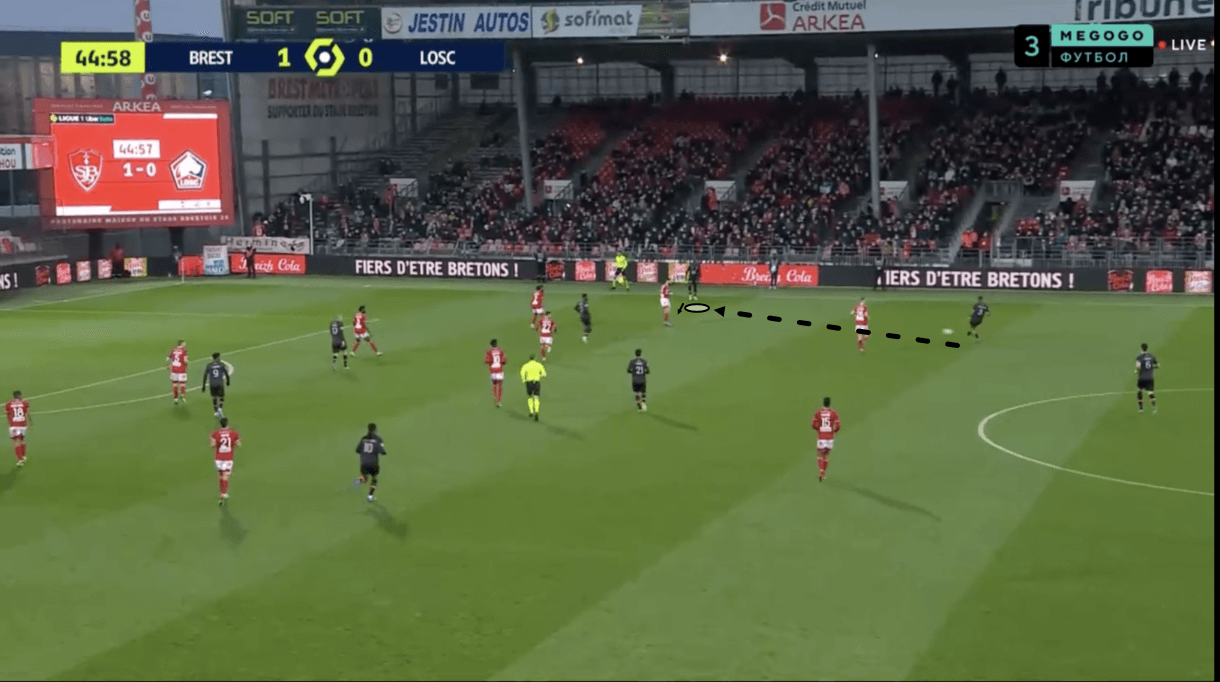
Firstly, as figure 1 shows, Weah likes to position himself very wide, getting chalk on his heels during the chance creation phase to make his team’s attacking shape wider, with the aim of also either 1. Stretching the opposition’s defensive shape, thus creating more space for his central teammates to play through them centrally or 2. Pulling the opposition left-back out wide and isolating him 1v1 — a situation in which Weah’s typically comfortable and, thanks to his 1v1 dribbling quality, often enjoys a qualitative advantage.
Within the context of his team’s attacking structure, Lille typically like to attack with a five-man forward line and Weah’s role is to provide the offensive width for his team on the right of this five-man attack — a role he performs very effectively, helped by his dribbling quality.
In figure 1, we see Lille playing the ball out to Weah on the right-wing as Les Dogues look to break into the final third. It’s worth noting how Weah positions his body while anticipating the pass; he doesn’t turn his back to the opposition’s half, rather keeps his body open to making it easy for him to see the pass and all movement going on behind him while at the same time making it easy for him to turn on receiving the ball to face the opposition’s goal and start moving forward.
As play moves on from figure 1, we see a good pass played to Weah’s stronger right foot which is positioned on the side of the opposition’s goal, that the USMNT international can receive while turning to immediately start charging into the final third after controlling the ball. The open body positioning, combined with a good pass from his teammate, allows Weah to quickly pick up speed on controlling the ball and turning which helps him to beat the opposition full-back on the outside, charge towards the byline and send a low driven cross into the penalty area for a teammate to get onto the end of just on the edge of the six-yard box. So, we see from this example how Weah’s intelligent body positioning can make it easier for him and his team to progress into the final third, thus creating more goalscoring opportunities. This has played a part in Weah’s increased creativity this season.
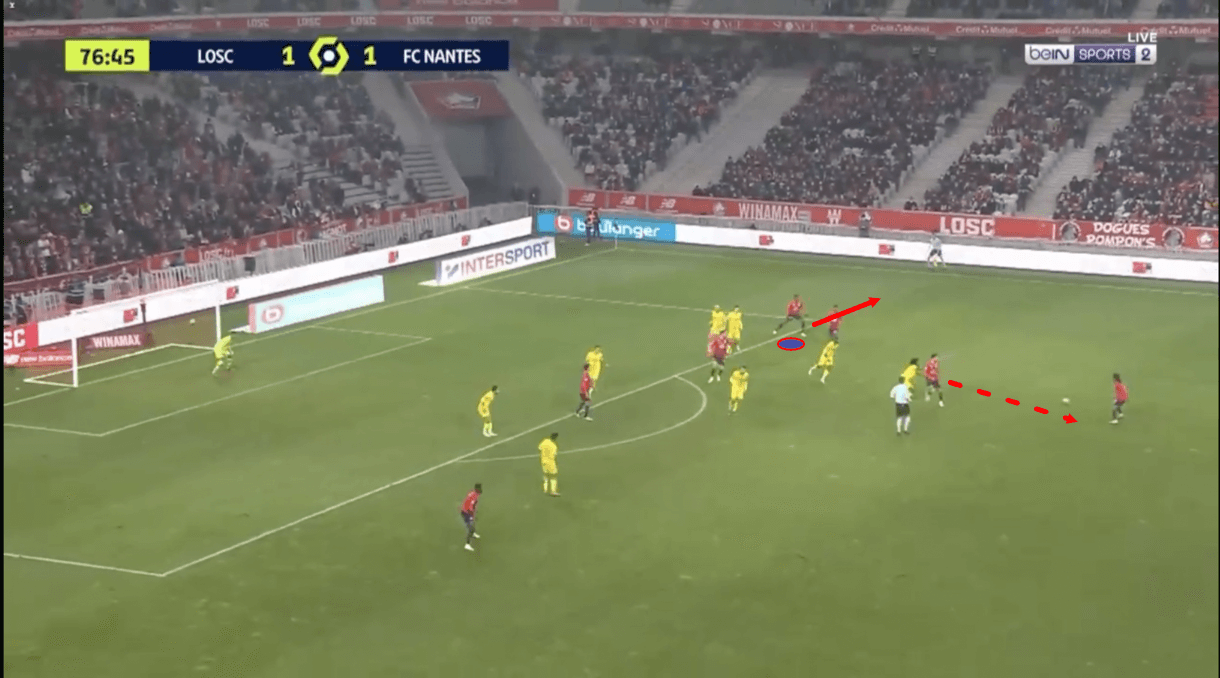
Figures 2-4 highlight another passage of play in which it’s clear how Weah’s conscious effort to move and position himself as wide as possible at the given moment helps his team to stretch the opposition and/or isolate himself versus an opposition full-back 1v1 to create an advantageous scenario for his side.
Starting with figure 2, just before this image, the ball was played back from one Lille attacker to Renato Sanches, occupying a central position just on the edge of the final third in this image. As Sanches prepares to receive possession, Weah immediately starts to back away from his narrower position just on the corner of the box here into a wider position.
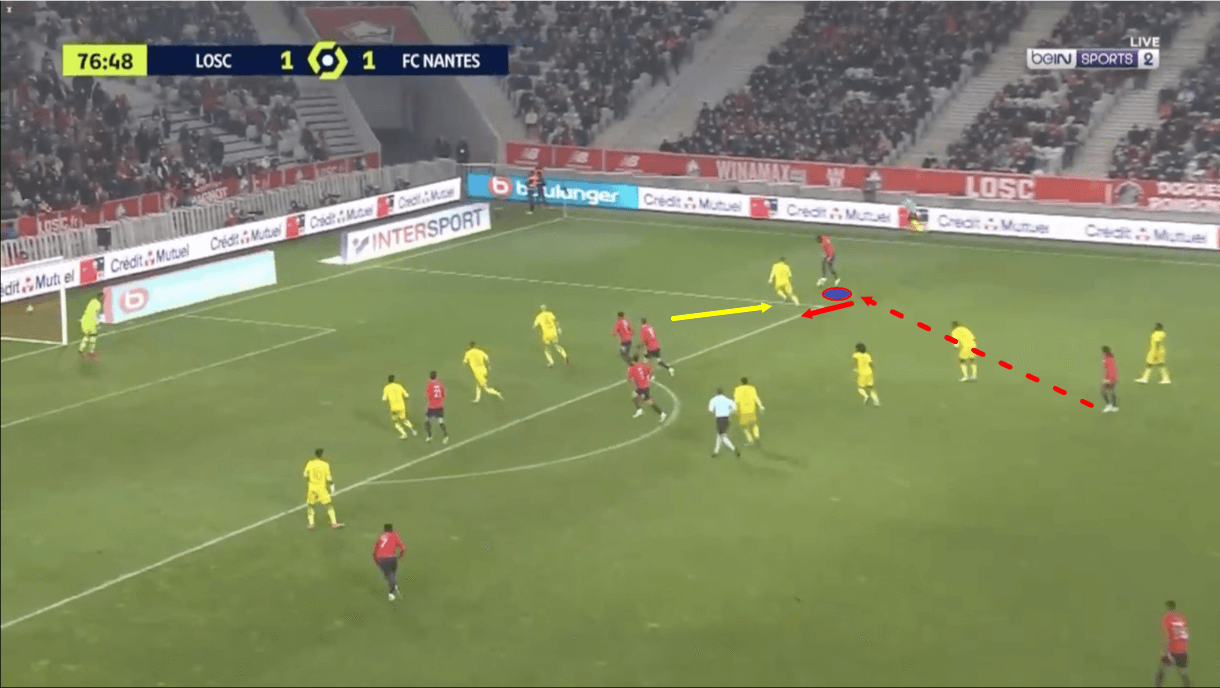
As play moves on into figure 3, we see how Weah’s intelligent movement and quick realisation of where there was space to exploit helped his team, as Sanches spotted the winger’s movement and gladly took up the passing option he provided, leading to Weah getting isolated 1v1 against a rushed opposition left-back scrambling to get out and close down the dribbler now carrying the ball towards the box and looking to break into the penalty area. This is exactly the type of scenario Weah loves to be in and the type of scenario in which the 22-year-old thrives thanks to his dribbling quality and top-notch pace. He’s very difficult to defend against 1v1 as we see here, hence why his movement and positioning to get wide on the right, thus often isolating himself versus the full-back, is so effective.
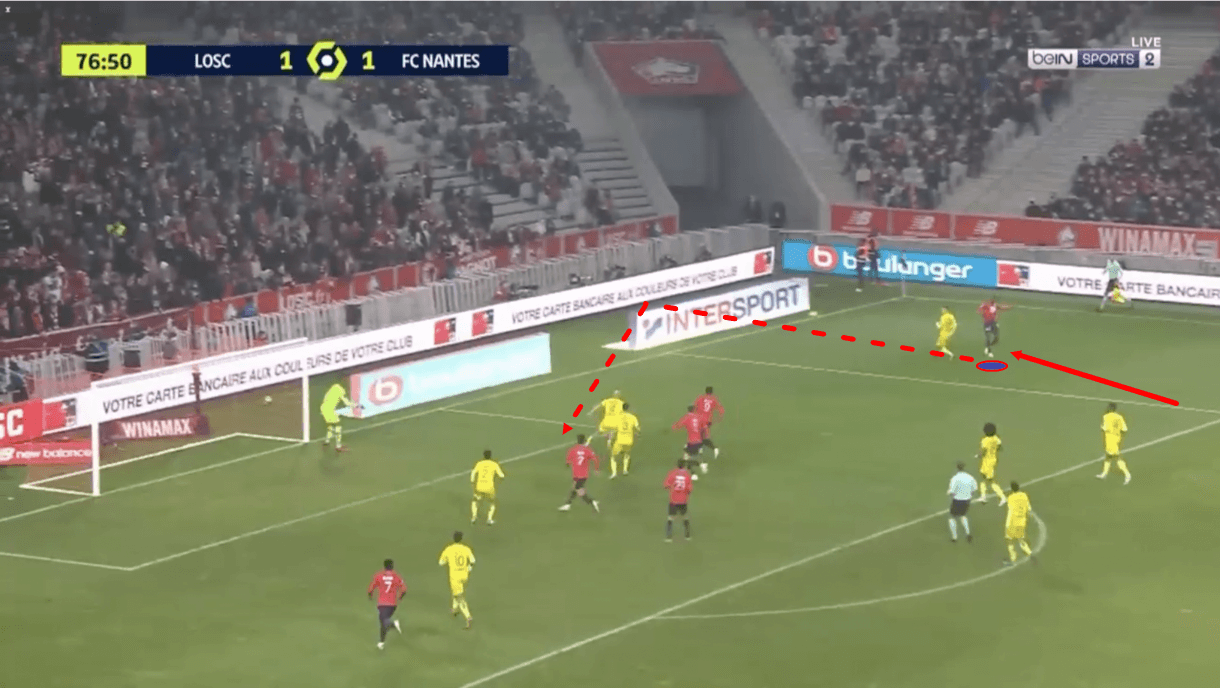
Weah typically takes the ball on the outside of the defender in these situations, with a degree of predictability perhaps a concern about his game. However, he’s very good at finding ways of getting around the defender 1v1 and creating crossing opportunities while protecting the ball despite the fact he generally does take the ball on the outside and is quite heavily right-footed. As we see in figure 4, he succeeded in bursting down the wing here, even taking the ball slightly wider than where we saw him in figure 3. This is another fairly common tendency in the winger’s game, he likes to take the ball a little bit wider when driving down the wing to protect the ball from the full-back and increase the space between him and the defender to open up the possibility of a cross.
This is a technique the attacker has used a lot this term and it’s generally been quite effective at helping Weah to get his crosses off often, with the USMNT international making the third-most crosses (3.61 per 90) of any Ligue 1 attacker to have played at least 500 minutes so far this term, per Wyscout. Weah routinely gets a nice whip on crosses like this, allowing him to bend them around the nearest defender before the ball curls back into the centre of the box. However, taking the ball wider before crossing can lead to Weah entering crosses at an awkward angle at times which can have a negative effect too if this technique fails. However, he’s been a high-volume crosser this term and retained a decent (32.5%) cross accuracy rate while adding plenty of threat for his side, as a crosser, from the right-wing so while there’s some clear room for improvement in this area of his game, it’s definitely something Lille have benefitted from this term.
Dribbling and pace
Weah’s dribbling has been the standout area of his game for me this season. The attacker has engaged in an average of 3.97 dribbles per 90 this term, which is above average compared to other Ligue 1 attackers, but he’s managed to retain a highly impressive 70.45% success rate in the process, which ranks him second out of all Ligue 1 wingers and centre-forwards with at least 500 minutes played. Weah could probably take more risks on the ball and dribble into central areas, for example carrying the ball into the right half-space, more often which could attract even more opposition bodies towards him, running a greater risk of being dispossessed but also potentially creating even more space for his teammates off the ball by drawing defenders to him.
At present, however, Weah tends to stay wider, focusing on drawing full-backs into isolated 1v1s and beating his man on the outside, which, of course, has also proven to be very beneficial for Lille this season, with Weah performing this role quite successfully.
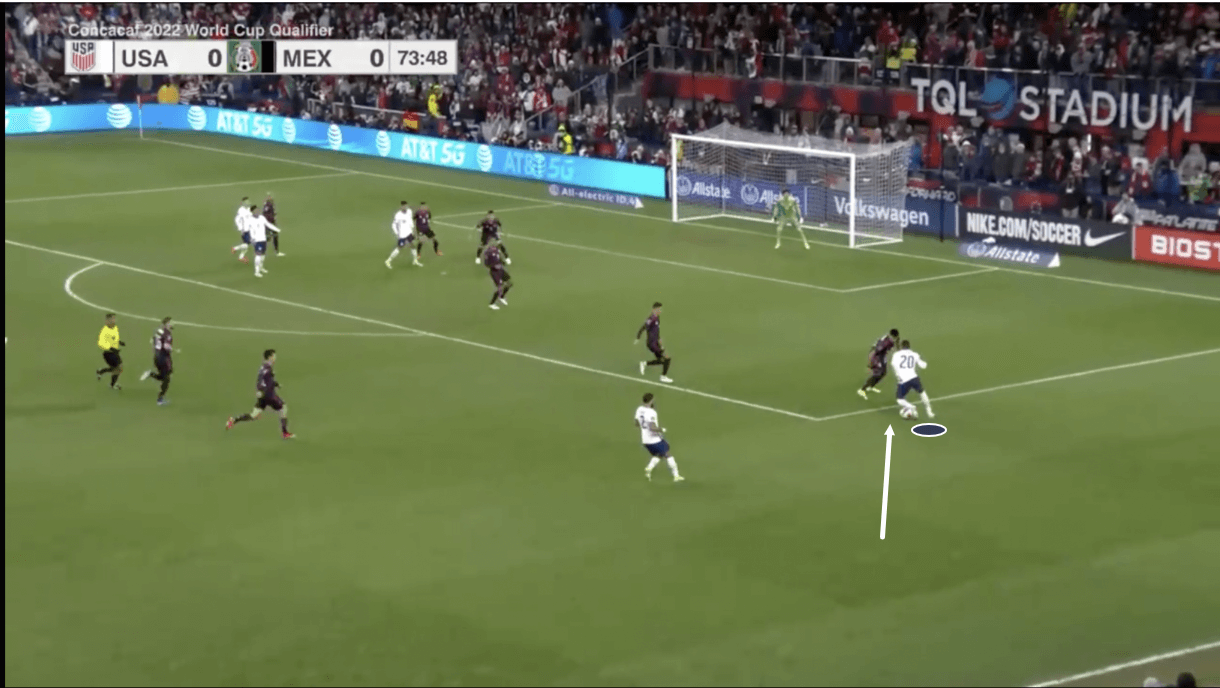
Figures 5-7 explore a passage of play in which Weah attacked an opposition full-back after isolating him in a 1v1, having just received the ball out wide in a deeper position before driving forward, attracting the full-back in as we see in figure 5. After driving forward and eventually getting quite close to the full-back, Weah performs a double stepover, first going with the right foot, then the left before exiting on the right by knocking the ball on his outside and driving down the wing.
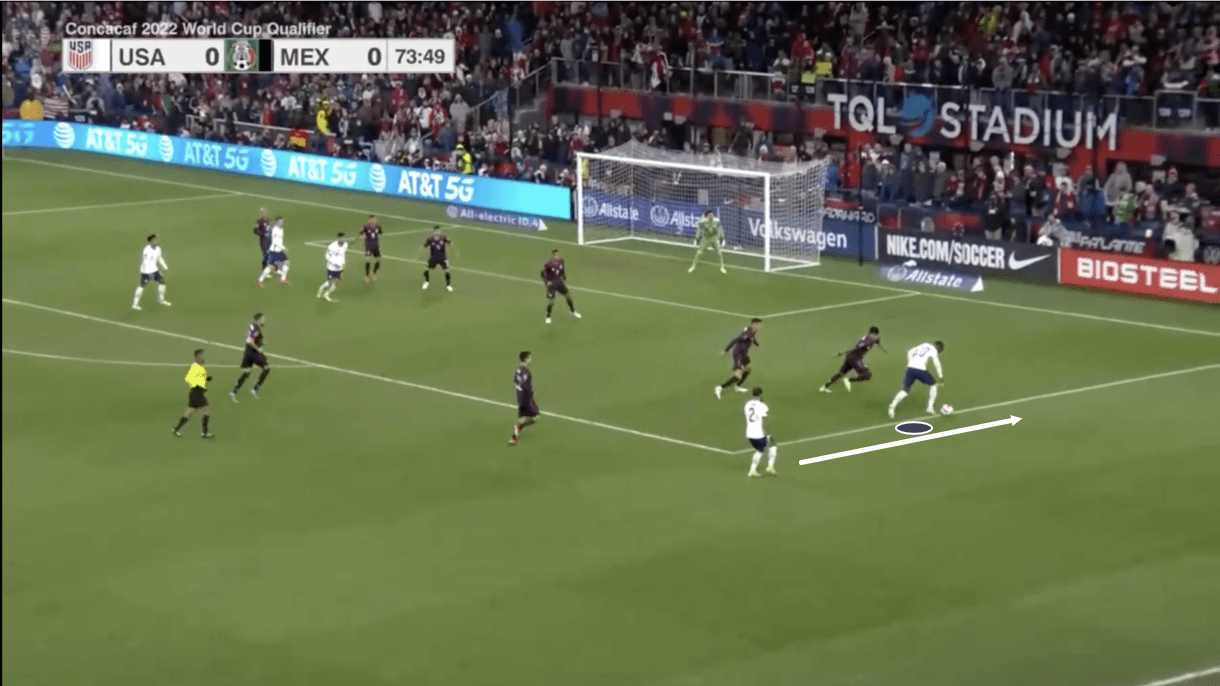
We see the result of this in figure 6, with Weah exiting on the right here, having created an extra inch or two of space for himself thanks to his tricky dribbling skill before which pushed and pulled the defender about, wrong-footing him and forging an opening for himself to knock the ball down the line, beyond the defender and into space. It’s common to see Weah turn very sharply when he views an opening for himself to get around the defender, as was the case here as well as in figures 2-4. Here, after turning sharply, we see the attacker knock the ball ahead of him into space to get beyond the defender, while backing his ability to get onto the ball without creating an opening for the defender to intercept, via his long strides and powerful legs.
The double stepover that Weah pulled off in figure 5 to create this opportunity to drive down the wing is another trademark of the American’s game that’s well worth noting. It’s very common to see the pacey wide man pull off a pair of quick and fluid stepovers to help his efforts in creating an opening to get around the defender on the outside, as we saw in this particular example. As Weah performed his stepovers, the defender shifted his weight to the side Weah was feinting towards and the winger was quicker to shift his weight back on the right and knock the ball on the outside than the defender was to shift his weight back onto his left side and block the attacker off.
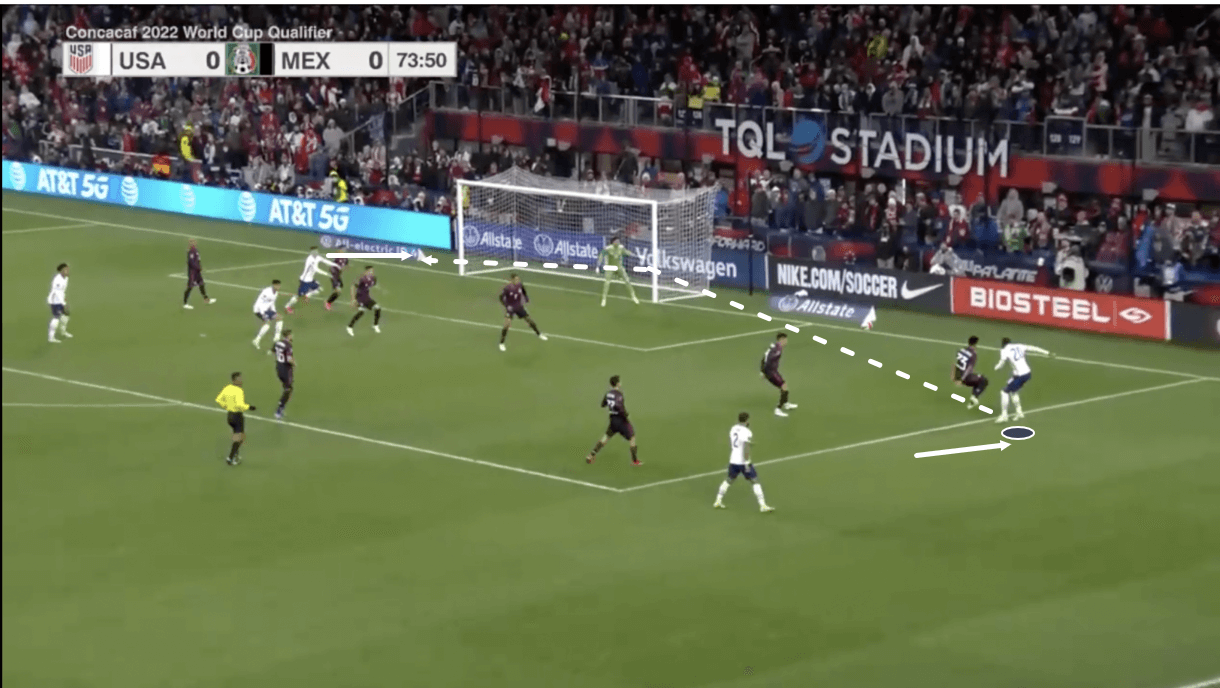
As play progresses into figure 7, we see how the winger once again managed to create an opportunity to whip the ball around the defender at the end of this drive down the wing, along the edge of the penalty area. Thanks to his tricky dribbling and quick acceleration to burst down the wing explosively after performing his couple of stepovers, Weah was able to find a way to get the defender out from between him and the goal, allowing him to land this whipped ball across the face of goal onto a teammate’s head.
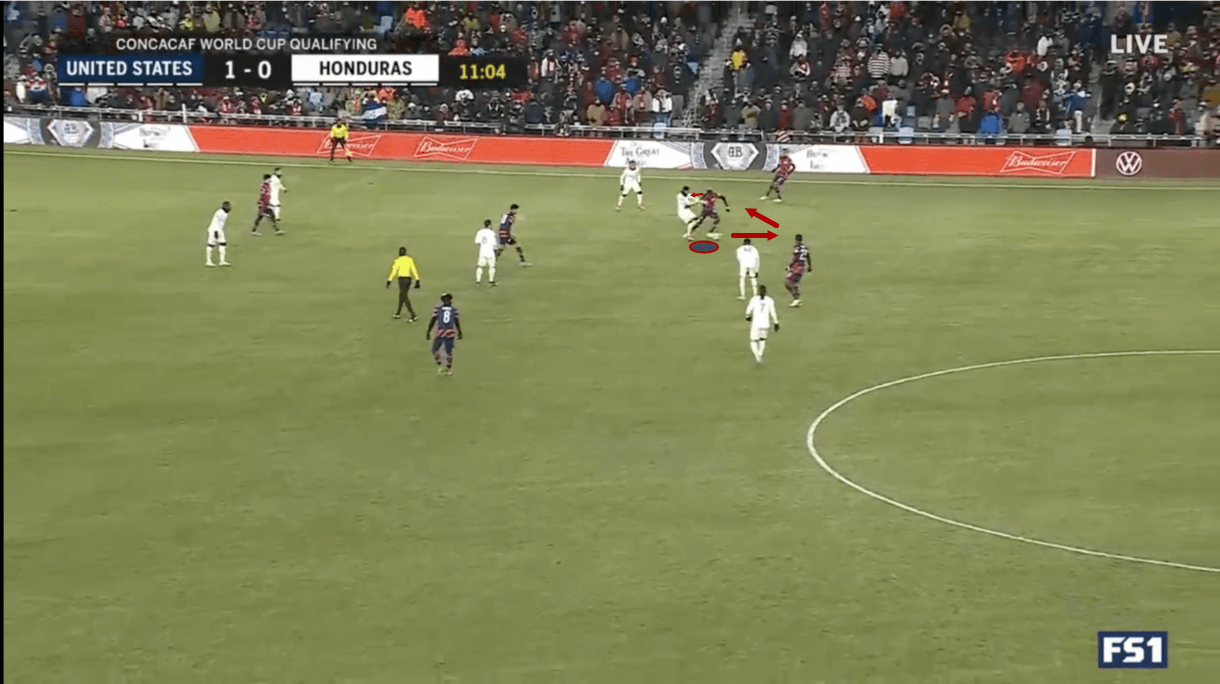
Along with pace and technical skill, Weah is good at using his 185cm frame to hold off defenders, another useful skill in the 22-year-old’s arsenal when dribbling and trying to beat opposition men, especially when receiving the ball. In figure 8, for example, Weah has just received the ball deep in the right half-space from a deeper teammate. On receiving the pass, Weah, demonstrating good awareness of his surroundings as well as good awareness of his own physical capabilities, backs into the defender with a slightly side-on body shape that allows him to lean back into the defender while keeping the ball a good distance away from the tackler.
Through the use of his strength and ball control here, Weah succeeded in keeping the ball away from the defender, throwing the opposition man off-balance and then almost ‘bouncing’ off him, if you like, as he escaped from the defender’s close marking and created some space for himself to turn and link up with a teammate before progressing upfield.
Weah is getting better and better at using his body to protect the ball and keep defenders at bay this season, as the 22-year-old gets more and more comfortable in his body. Weah is a decent size for a wide attacker and demonstrates a decent level of strength at times, when required, as we see in figure 8.
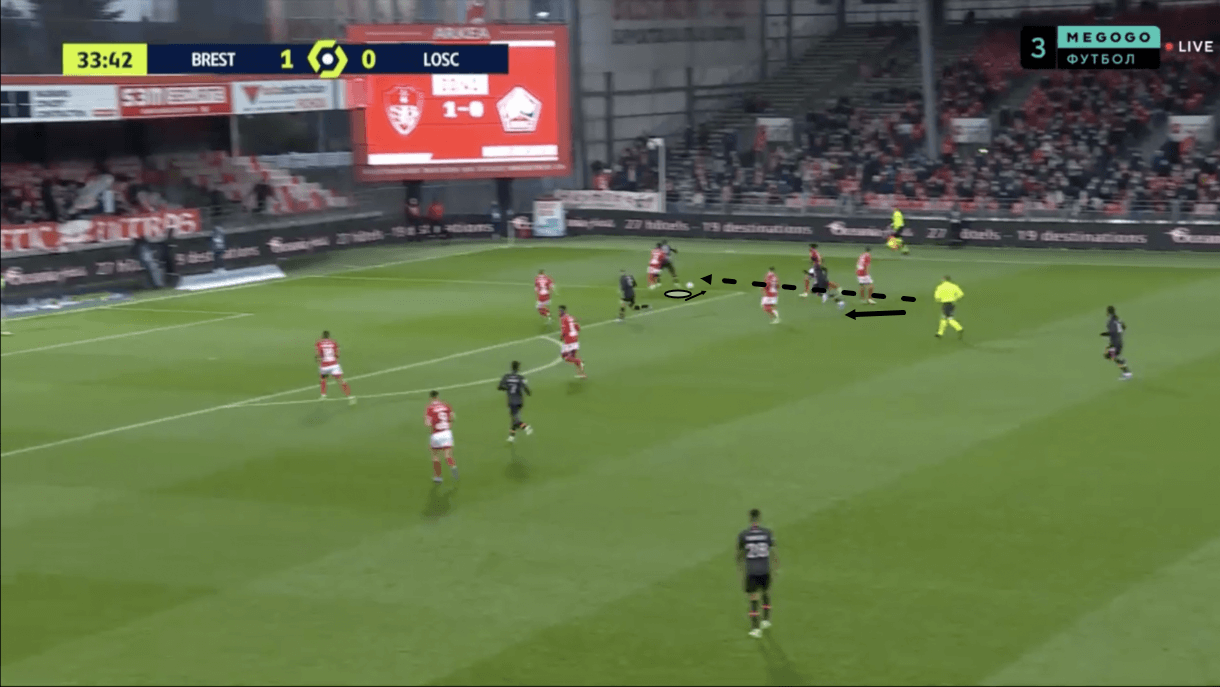
We see another example of how Weah likes to protect the ball from a defender when receiving by placing himself between them and it with his back to the defender in figure 9 — again, showcasing how comfortable the winger is with an opposition defender on his back. Here, the ball has been played into Weah’s running path on the wing and before receiving the ball, he’s opted to turn his back to the defender goal-side of him, ensuring he doesn’t get the ball immediately nicked away due to not offering it enough protection.
This decision again allows Weah to gain control of the ball before, yet again, knocking it down the wing ahead of him into his running path, backing his pace and agility to help him turn and get onto the ball before the defender. From there, after making his strong first touch knocking the ball outside the defender towards the byline, he can chase the ball down and, all going to plan, get around the defender and into a decent crossing position.
As play moves on from this point in figure 9, we actually see Weah reach the byline with the ball from where he can drill a low cutback cross into the box to find a teammate in a dangerous position with a powerful, pacey ball into the feet. While we’ve looked at a couple of examples of Weah whipping a ball into the box so far in this scout report, his preferred type of cross is probably the low driven cutback cross into the penalty area from the byline, with the whipped cross acting as a close second. We’ve now seen examples of how Weah’s dribbling techniques and rapid pace have helped him to set up both of those types of crosses in this tactical analysis.
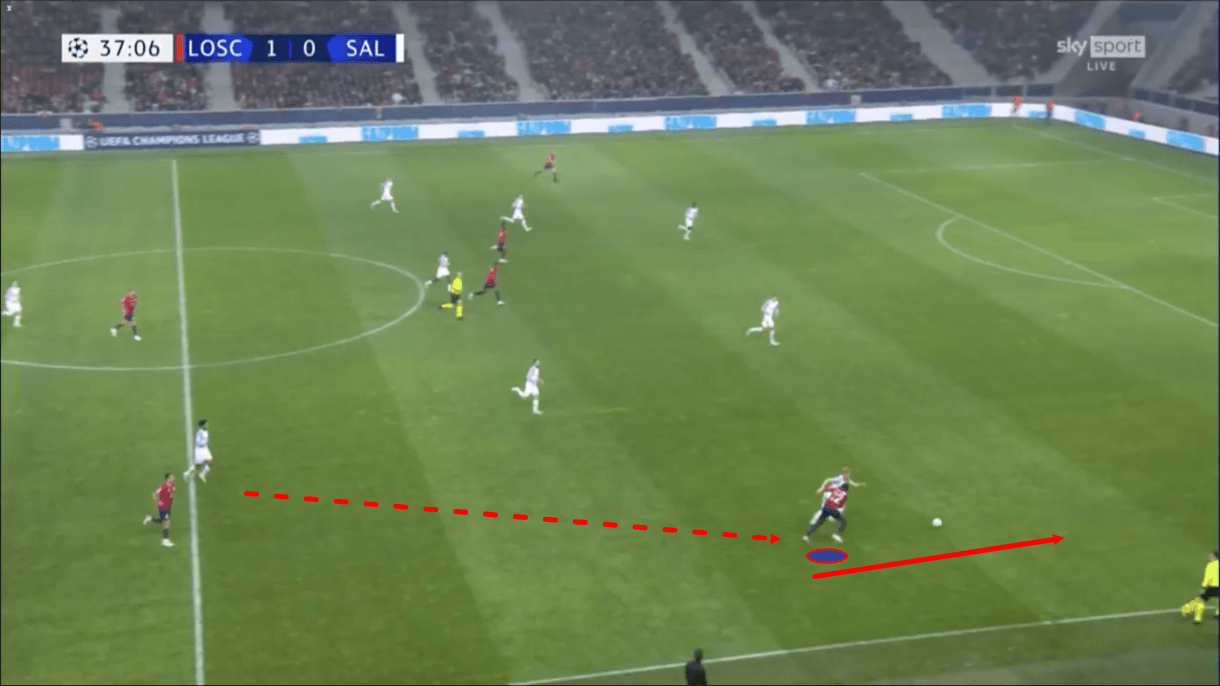
Weah is very comfortable with relying on his pace, which does help him to beat lots of defenders 1v1 in a foot race if he’s given the space to sprint into on the wing, as figures 10-11 will show an example of. Firstly, here we see Weah chasing down the ball having just knocked it beyond the defender on the right wing after previously receiving a pass from his right central midfielder in a slightly deeper position, resulting in him drawing the opposition full-back out from the back towards him to create this 1v1.
Just like in the previous examples in this section, we see Weah knocking the ball well ahead of himself and the defender here, backing his ability to beat the defender in a foot race and get onto the end of the ball before the opponent, which is what happens here. Weah has the acceleration and blistering pace to get past most full-backs in a situation like this, so it does make sense why he routinely knocks the ball ahead like this after drawing the defender in, especially as the defenders usually have a sharper turn to make than Weah when he does opt to drive down the wing like this. In general, however, Weah is happy to draw the defender in to exploit the space this then opens up behind said defender, as we see in figure 10.
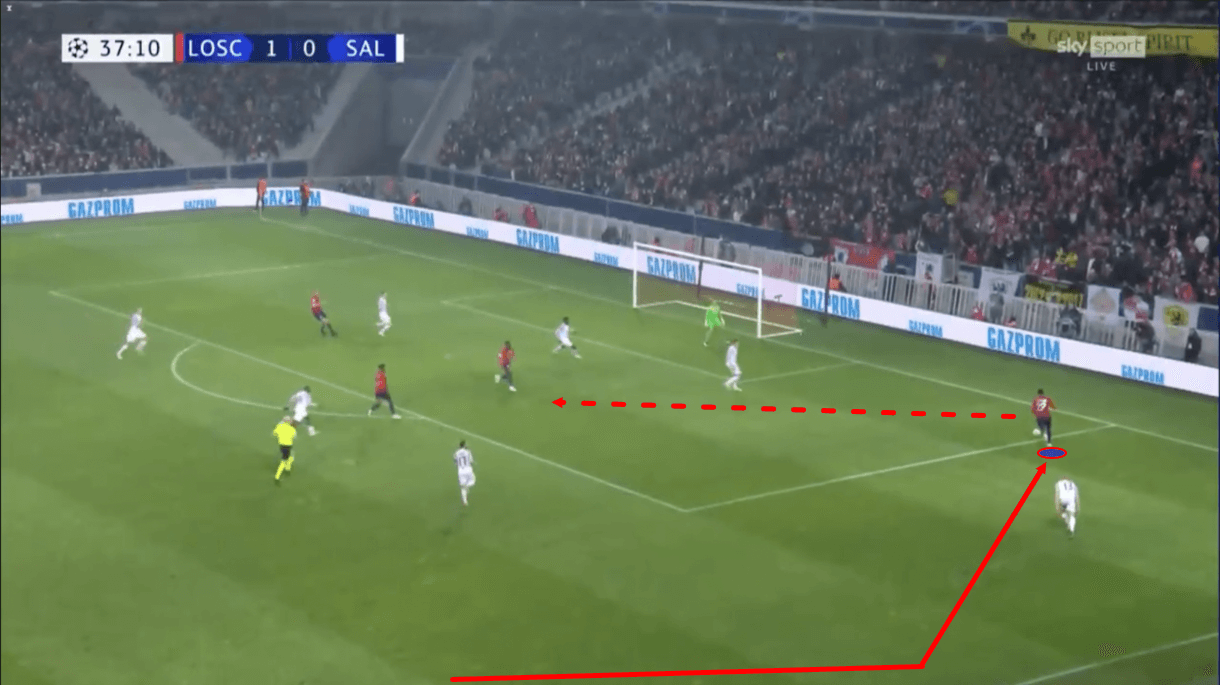
Moving on into figure 11, we see the result of Weah’s sprint down the right wing, with the attacker having progressed into a highly dangerous position to perform a low cutback cross into the danger zone from the byline just inside the penalty area. His bet on himself to win the 1v1 foot race paid off, as he successfully got onto the end of the ball before the defender, allowing him to knock the ball further down the line to give him more space to break away into and stretch his long legs to really maximise his sprinting capacity.
Despite moving at such a fast pace, Weah was able to turn very well while retaining his balance. He didn’t perform an extremely sharp turn, nor will you see him do so when sprinting like this, but he was able to turn ever so slightly to create a better crossing angle for himself. The defender with him, off the ball, was far less successful in turning and keeping up with Weah, with the defender ending up on the floor after tripping in trying to keep up with the Lille winger. This highlights the benefit of Weah’s impressive combination of blistering pace and quality dribbling skill, as discussed in this tactical analysis.
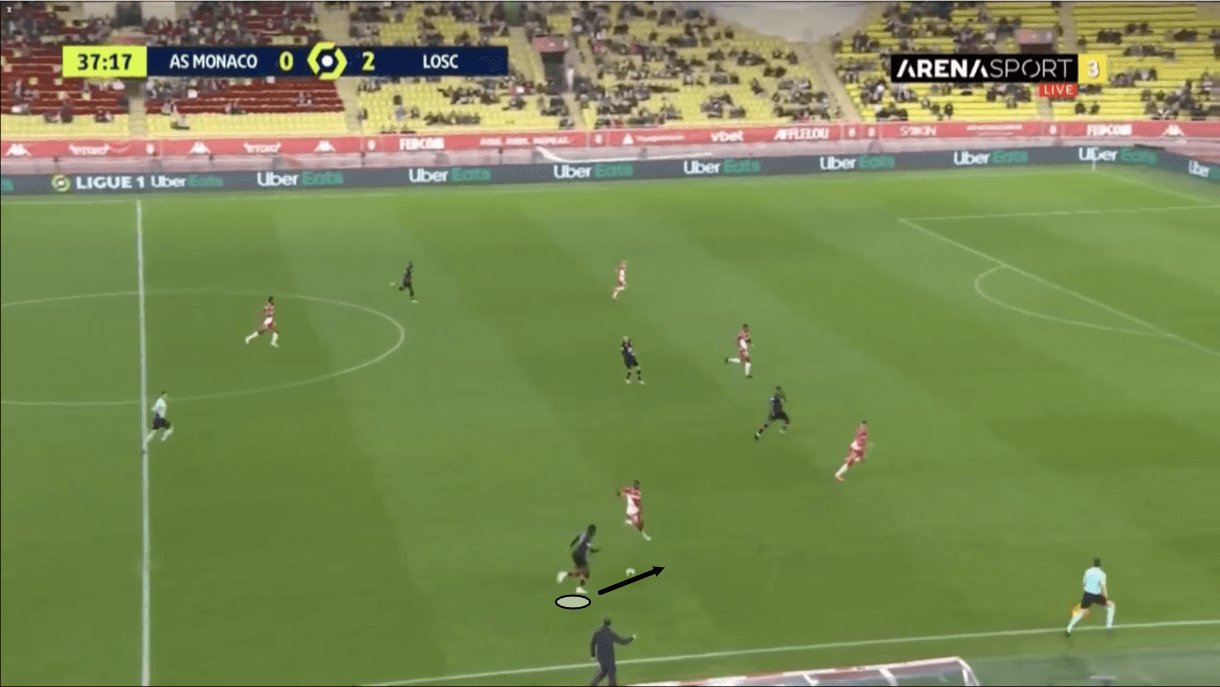
Another technique we’ve seen Weah sometimes use when trying to draw defenders in this season has been to take one or two heavy touches at the beginning of his dribble when moving at a slower pace to try and convince a defender to take the bait. We see an example of one such situation here in figure 12, with Weah having just knocked the ball ahead of himself here intending to attract increased pressure from the defender.
The winger’s aim here, of course, was to create an opportunity to exploit space behind the pressing defender. However, this particular technique of Weah’s isn’t always very successful, as it can lead to the opposition just stealing the ball away from him, which can be easier for them in situations like this because Weah’s moving at a slower pace, at the very beginning of his dribble. In figure 12, Weah’s attempt to draw the defender in with heavy touches backfired, as the defender was ultimately able to disrupt the dribble and win possession for his side. This is the high-risk, high-reward nature of being a dribbler but I think this particular technique for trying to bait the defender in is not one that’s been delivering particularly great rewards when compared to some of the other dribbling techniques Weah has utilised this term, so I’d say this is something that either needs to be improved upon or needs to be eradicated from the Lille man’s game.
Defending
This tactical analysis and scout report on Weah wouldn’t be complete without taking a look at his defensive contribution. The 22-year-old demonstrates a good work rate without the ball and aided by his pace and strength, he can pose quite a formidable pressing threat, though Weah can still improve on his defensive positioning to lessen his reliance on pace in all different areas of the game.
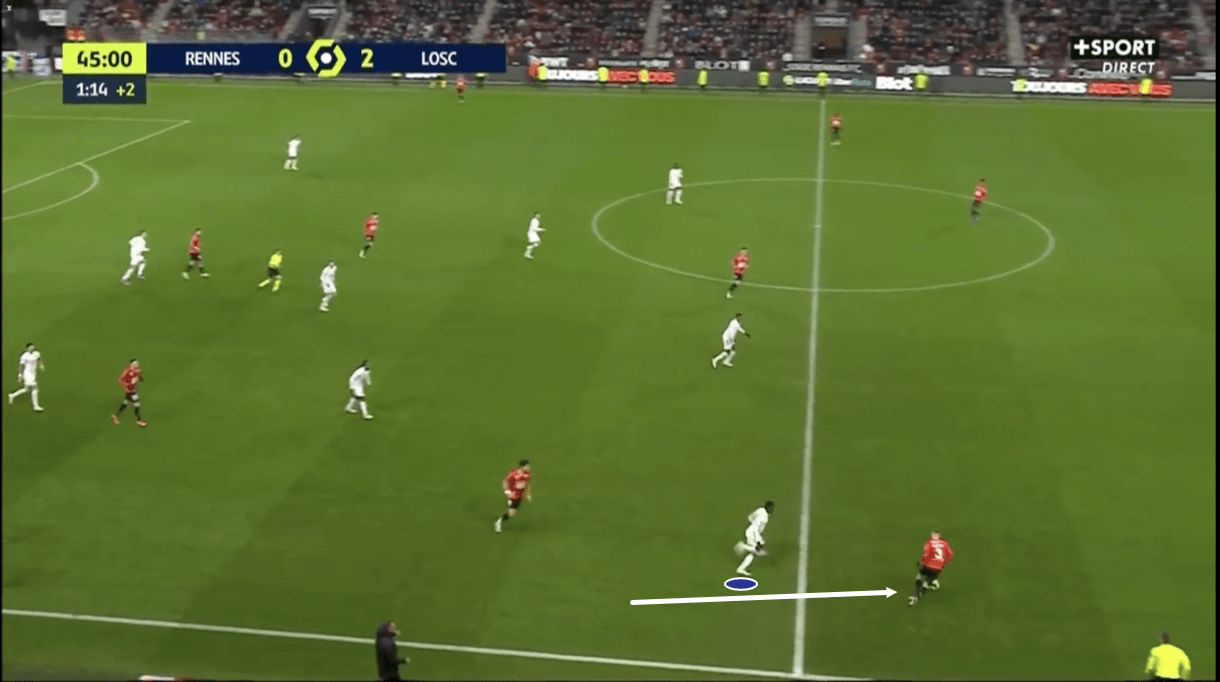
It’s common to see Lille increase their pressing intensity on a backwards pass from the opposition and this is exactly what we see transpiring in figure 3. Before figure 13, the ball was sent to the player occupying the left-back position from his midfield teammate and as this wide man attempts to control the ball, Weah charges him down immediately with the aim of preventing him from really gaining any control over it at all.
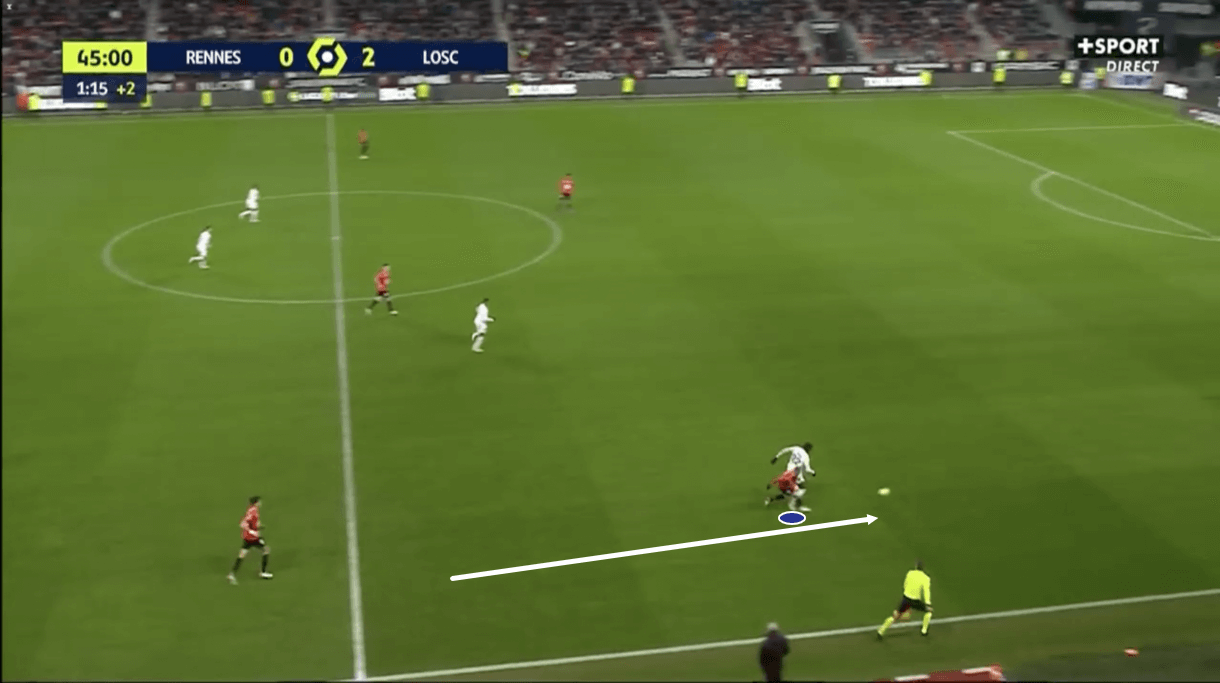
Moving on into figure 14, we see that Weah was successful in this endeavour as he quickly made up ground on the opposition ball carrier, likely closing him down far quicker than he’d expected, leading to the ball carrier getting caught in possession and a high turnover in favour of Lille.
Weah is an excellent asset for quickly charging players down like this. In terms of catching players off-guard with the rate of his acceleration, his physicality and overall work rate without the ball, it’s difficult not to see the USMNT international as a great asset for his side off the ball.
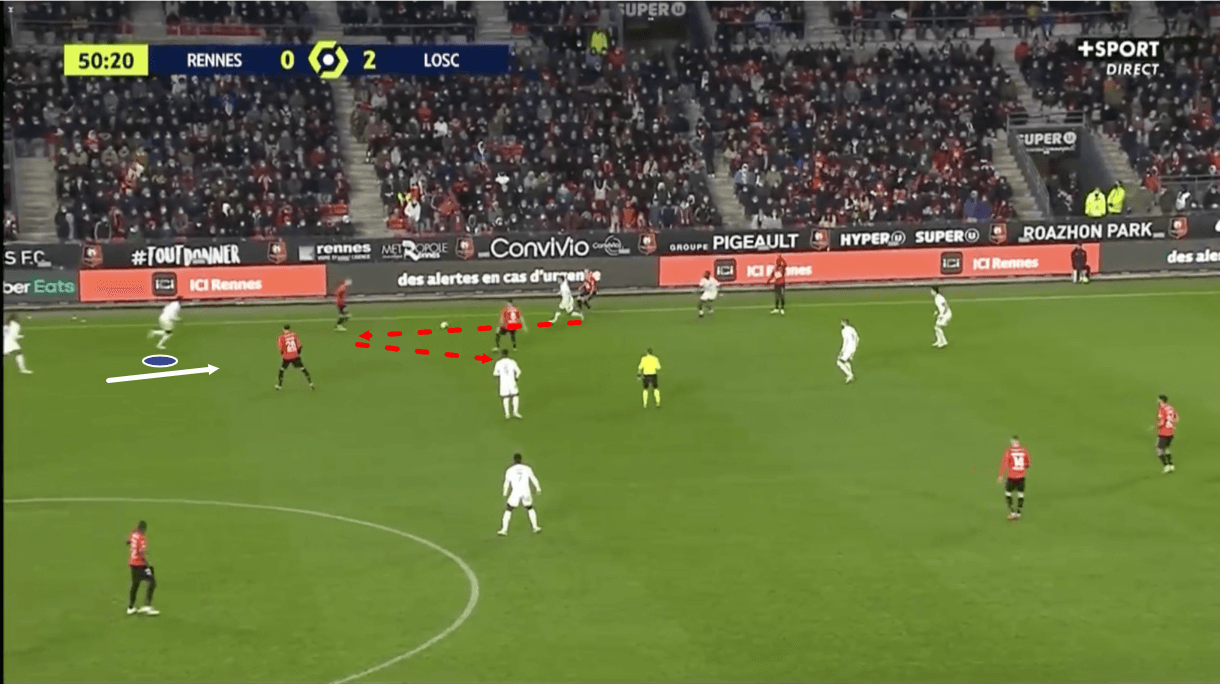
Weah is similarly very comfortable with tracking back to aide his side’s defensive efforts, as figures 15-16 demonstrate. Again, his speed, strength, and overall work rate were crucial here in helping his side to regain possession. Firstly, we see the opposition sending the ball back to the wide man closest to Weah here in figure 15. At this moment, as the pass is played into that deep-lying wide man’s feet, Weah bursts into action to close the player down from behind to limit their time on the ball and pressure them into a rushed decision that could work out in favour of his side as a result of the decision being rushed.
However, the attacker responded to the situation well by quickly playing a pass inside to his slightly more central teammate, getting the ball slightly more out of harm’s way from his opponent.
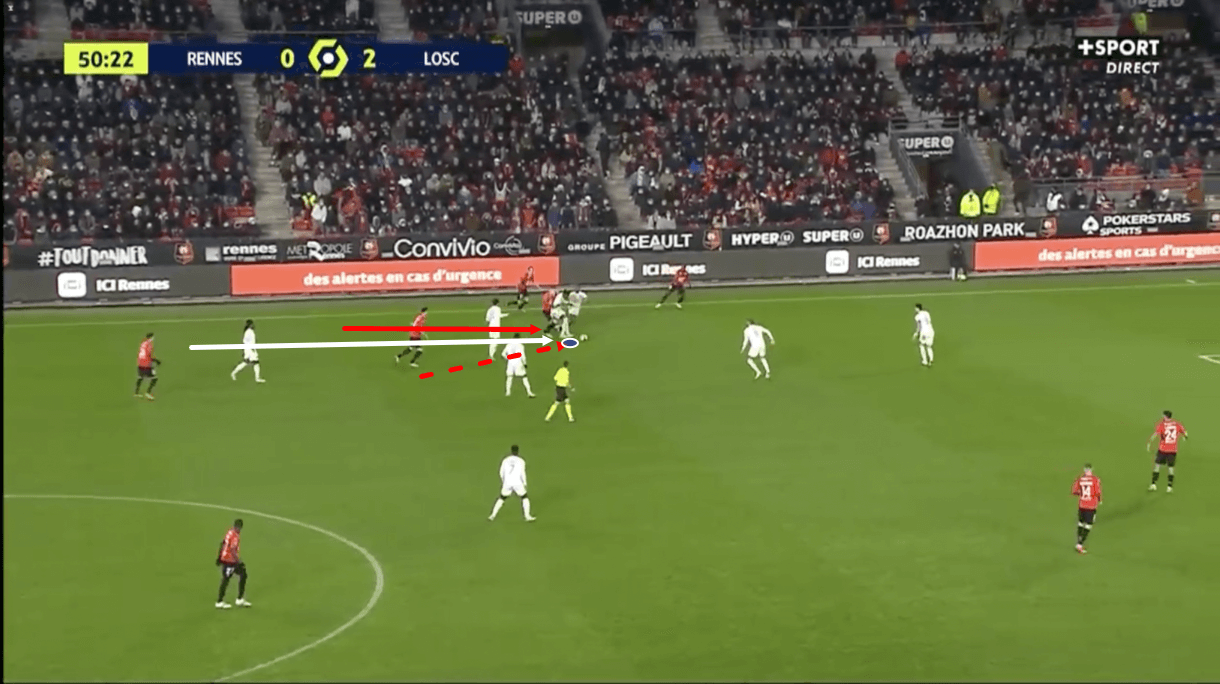
However, as play progresses into figure 16, we see that as this more central player attempted to pass the ball back to his teammate who ran into space on the wing after passing the ball inside in search of a one-two, he was tracked very closely by Weah and as soon as this pass was played, the American winger pounced, diving in front of the runner and aggressively taking back possession for Lille.
As is evident in figure 16, along with the pace and work-rate to get back into this position to stop the attempted progression down the wing, Weah demonstrated excellent strength yet again to hold off the runner once he was positioned between the man and the ball, buying himself some time to hold the attacker off before laying the ball off to a teammate and kickstarting a counter-attack of their own for Les Dogues. So, these two examples — one showing an aggressive high press and the other showing some diligent, hard-working, tracking back — both highlight the benefits for Lille in having such a defensively active player, in the form of Weah, in their ranks. Weah is certainly not the type of player who contributes little in a game if they fail to contribute to a goal, rather he’s the opposite — someone who contributes a lot through his off the ball defensive actions as well as positioning and ball carrying ability to constantly increase his team’s threat.
Conclusion
To conclude this tactical analysis and scout report, I feel it’s clear that the big positives in Weah’s game are his dribbling, positioning, movement and defensive work rate. Weah also has some great physical assets that make him a difficult proposition for defenders to deal with him in terms of strength or in terms of pace. To continue his positive trajectory, I’d like to see Weah focus on 1. Taking even more risks when carrying the ball forward (carrying the ball into more central zones and taking defenders on even more) and 2. Work on his crossing technique and maybe make it more consistent with fewer instances of entering crosses off-balance, which does happen on occasion.




Comments